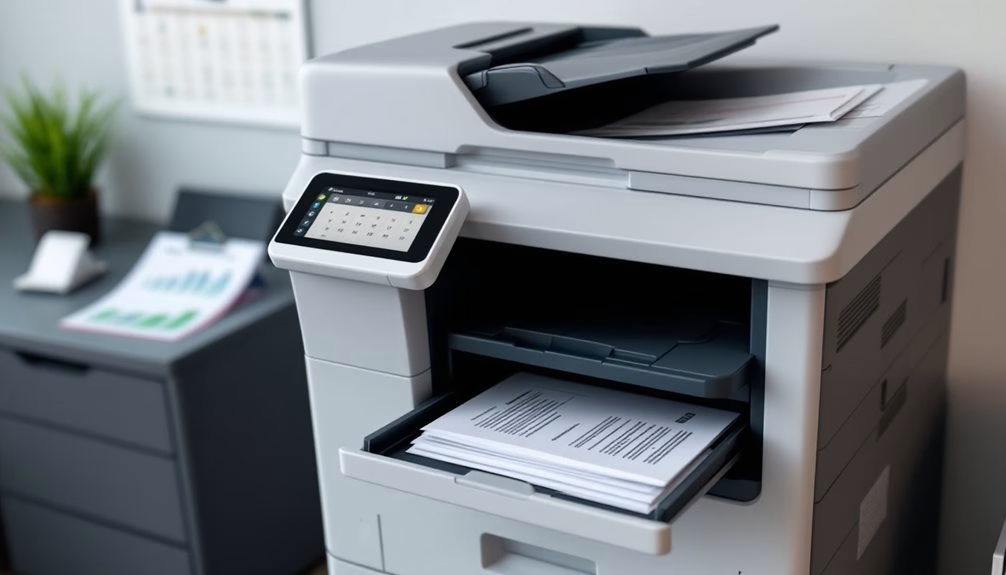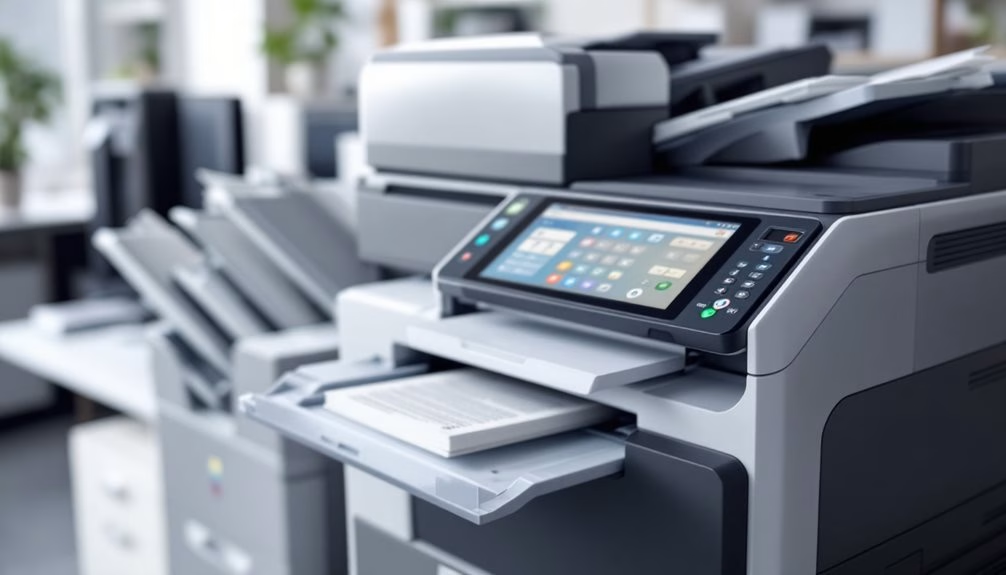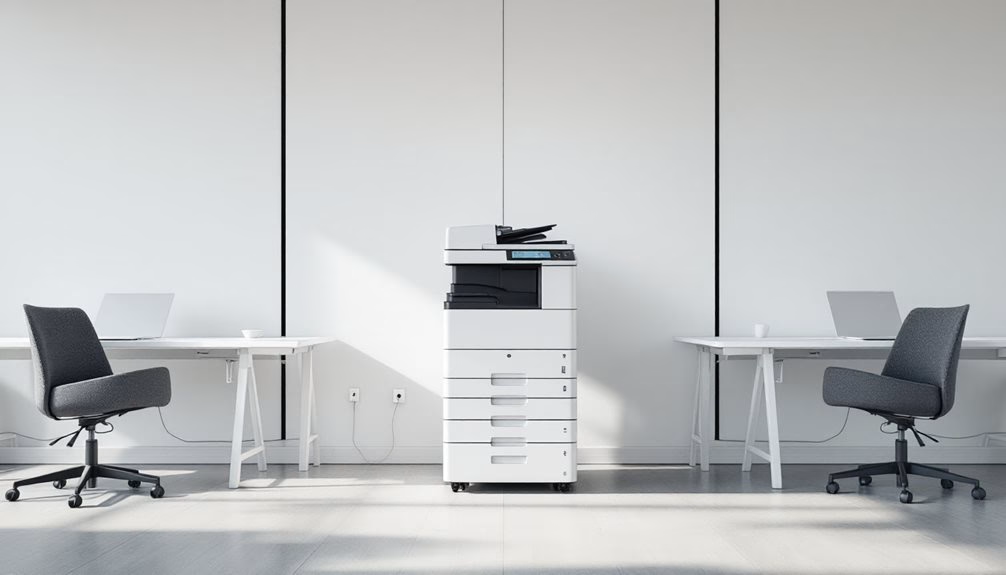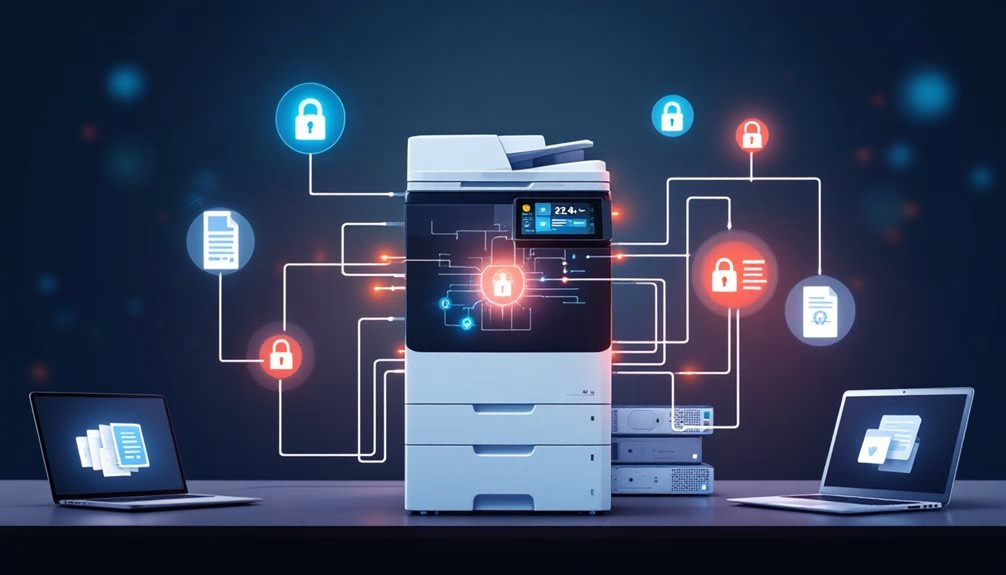We’ve all faced that moment when it’s time to select a new office copier, and let’s be honest – it’s not the most thrilling task we’ll tackle this year. But making the wrong choice can lead to frustrated employees, wasted money, and endless maintenance headaches. Whether you’re expanding your business or replacing outdated equipment, we’ll show you how to navigate the essential factors that’ll make this decision a success for your team.
Expert Highlights
- Calculate your monthly print volume and choose a copier that can handle 10% more than your peak demand requirements.
- Compare essential features like print speed, scanning resolution, and network integration capabilities to match your office workflow.
- Evaluate whether purchasing or leasing is more cost-effective, considering initial investment, maintenance costs, and tax implications.
- Assess available office space, power requirements, and noise factors when deciding on copier placement and model type.
- Review service contracts carefully, including response times, maintenance schedules, and supply management options before making a final decision.
Assessing Your Monthly Print Volume and Speed Requirements

Before selecting a new copier, you’ll need to calculate your office’s average monthly print volume and required print speed.
Take time to monitor your current usage over several months, tracking both individual and departmental copying needs. This data helps determine the right machine capacity.
Tracking your office’s copying patterns over time reveals true usage needs, enabling smarter decisions about copier capacity requirements.
For print speed, observe your peak usage periods.
We recommend choosing a copier that can handle your busiest times without creating bottlenecks. A good rule is to select a machine that processes 10% more pages per minute than your current peak demand to guarantee smooth workflow and prevent staff frustration.
Our expert consultations can help evaluate whether high-capacity printers would be better suited for your office’s specific workflow optimization needs.
Understanding Key Features and Multifunction Capabilities

We’ll want to compare essential features across different copier models, including automatic document feeders, paper handling capacity, and scanning resolution.
Beyond basic copying, today’s multifunction machines let’s print, scan, fax, and even handle cloud-based document management.
The right combination of speed and functionality will depend on whether we need a workhorse for high-volume printing or a versatile machine that excels at multiple tasks.
Working with experienced sales consultants can help you navigate the numerous options available and identify equipment that aligns with your specific volume needs and budget constraints.
Essential Features to Compare
When comparing office copiers, understanding the key features and multifunction capabilities will help you make an informed decision for your business needs.
Let’s focus on the essential features to evaluate: print speed (pages per minute), paper capacity, scanning resolution, document feeder capacity, and monthly duty cycle.
We’ll want to take into account network connectivity options, color versus black-and-white capabilities, and finishing options like stapling and collating.
Don’t forget to assess memory capacity, hard drive storage, and security features that protect sensitive documents.
Energy efficiency ratings and mobile printing compatibility are also vital in today’s workplace.
Print Speed and Functions
Print speed and multifunction capabilities directly impact your office’s productivity and workflow efficiency. We recommend choosing a copier that matches your daily print volume – typically measured in pages per minute (ppm).
For small offices, 25-35 ppm usually suffices, while larger operations may need 45+ ppm.
Look for multifunction features that serve your team’s needs. Modern copiers can scan, fax, email documents, and enable mobile printing.
Some offer automatic document feeders, duplex printing, and sorting capabilities. You’ll also want to evaluate advanced functions like secure printing and cloud connectivity to enhance your workflow.
Budget Planning: Purchase vs. Lease Options

When we’re looking at copier costs, we’ll need to examine both the one-time purchase price and the recurring expenses like supplies, maintenance, and service contracts.
If we choose to buy, we’re typically looking at a larger upfront investment ranging from $3,000 to $50,000 depending on the model, while leasing offers lower initial costs with monthly payments between $100-500.
Let’s break down these numbers to help you decide which option makes the most financial sense for your business.
Leasing provides tax advantages since payments can be deducted as operating expenses rather than depreciating a purchased asset.
Upfront Costs Breakdown
Before committing to a new office copier, understanding the financial implications of purchasing versus leasing is essential for your budget planning. Let’s break down the upfront costs you’ll encounter to help make your decision clearer.
| Cost Type | Purchase | Lease |
|---|---|---|
| Initial Payment | Full price | First month’s payment |
| Installation | One-time fee | Often included |
| Training | Additional cost | Usually included |
| Maintenance Kit | Must purchase | Included in contract |
We recommend carefully reviewing these costs against your available capital and monthly operating budget to determine which option best serves your organization’s needs.
Monthly Payment Comparisons
Understanding monthly payment structures can dramatically impact your long-term office budget.
When comparing lease payments versus purchase financing, we’ll typically find leases ranging from $100-500 monthly for basic models and $500-1,500 for advanced systems. Purchasing often requires $200-800 monthly payments over 3-5 years.
We recommend calculating total costs over time. While leasing might offer lower monthly payments, you’ll continue paying indefinitely.
With purchasing, you’ll own the machine after the loan term ends. Consider your cash flow needs and whether you’d prefer predictable monthly expenses or building equity in your equipment.
Space and Location Considerations

Three key factors about space and location can make or break your copier decision.
Let’s consider these essential elements to guarantee your team can work efficiently and comfortably with the new machine.
- Available floor space – we’ll need room for the copier itself plus adequate clearance for paper loading, maintenance access, and user operation.
- Power requirements – we must verify your location has proper electrical outlets and capacity for the model you select.
- Noise considerations – we should position the copier away from quiet work areas while keeping it conveniently accessible to those who’ll use it most.
Selecting between desktop models and floor-standing options greatly impacts your workspace utilization and overall office layout.
Network Integration and Security Features

Modern copiers serve as networked devices that require careful security planning. We need to guarantee our copiers integrate seamlessly with existing network infrastructure while maintaining data protection standards.
Let’s examine key security features: user authentication prevents unauthorized access, data encryption protects sensitive information, and secure print release holds documents until users enter their codes.
We’ll want automatic hard drive wiping to remove stored document data.
Consider whether the copier supports your current network protocols and security certificates.
Don’t forget to check if it’s compatible with your document management system and can handle departmental access controls.
Implementing a Managed Print Services solution can strengthen security of sensitive documents with advanced protection protocols that safeguard your business information.
Service Contracts and Support Options
Strong service agreements form the foundation of reliable copier performance. When selecting support options, we’ll want to verify we’re getting thorough coverage that protects our investment and minimizes downtime for those who depend on these machines.
- Look for contracts offering same-day or next-day service with guaranteed response times
- Compare preventive maintenance schedules that include regular cleaning and parts replacement
- Evaluate supply management options where vendors monitor and automatically deliver toner
Remember to review the contract’s fine print regarding parts coverage, labor costs, and service hour limitations. We don’t want unexpected expenses when our team needs support most.
Frequently Asked Questions
How Long Does It Typically Take for a New Copier to Arrive?
We can expect a new copier to arrive within 3-7 business days for standard models. If you’ve ordered a specialized or customized machine, delivery might take 2-3 weeks.
What Happens if the Copier Breaks Down During an Important Deadline?
We’ll help you stay productive by providing same-day service calls, temporary replacement units, and backup solutions. Most service providers offer priority response when you’re facing urgent deadlines.
Can Multiple Departments Have Separate Access Codes for Usage Tracking?
We’ll help you set up unique access codes for each department, making it easy to track copying usage, control costs, and generate detailed reports for accurate interdepartmental billing.
Are Eco-Friendly or Recycled Paper Options Compatible With All Copiers?
We’ll want to check each copier’s specifications, as most modern machines work well with recycled paper. However, some eco-friendly papers may need special settings for maximum performance.
What’s the Average Lifespan of a Commercial Office Copier?
We’ll see commercial copiers typically last 5-7 years with proper maintenance, though it’s not uncommon for well-maintained machines to reach 10 years while serving your office’s needs efficiently.
Expert Final Thoughts
We’ve covered the essential factors in selecting the right office copier, from print volume assessment to service contracts. Remember, we’re not just buying a machine – we’re investing in our office’s productivity. Let’s take time to evaluate our needs, compare options, and choose a solution that matches our workflow and budget. When we do our homework, we’ll find the perfect copier for our workspace.
About the Expert
Rafael M.
CEO of JR Copier
With over 35 years of hands-on experience in the copier and office printer industry, Rafael brings unparalleled expertise to every client interaction. His journey from service technician to CEO provides him with comprehensive understanding of all aspects of the business.
Areas of Expertise: Copier and printer sales, equipment leasing strategies, maintenance solutions, and managed print services. Rafael's deep industry knowledge ensures clients receive expert guidance, transparent pricing, and exceptional service for all their office equipment needs.
Connect on LinkedIn